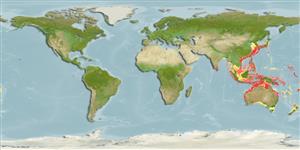Issue
FishBase common name changed from Yellow striped goatfish to Yellowband goatfish (Uiblein et al., 2024: Ref. 130857).
Environment: milieu / climate zone / depth range / distribution range
Ecologia
marinhas demersal; intervalo de profundidade 20 - 200 m (Ref. 54393), usually 74 - 78 m (Ref. 54393). Tropical
Indo-West Pacific: disjunct distribution: Japan to coast of Aomori Prefecture, Honshu, the Izu Peninsula, Kochi Pref., Ogasawara Islands and southeastern Taiwan; in the south from the Arafura Sea, the NW shelf and Kimberly region of Western Australia; from Geographe Bay northwards.
Tamanho / Peso / Idade
Maturity: Lm ? range ? - ? cm
Max length : 55.0 cm TL macho/indeterminado; (Ref. 48636)
Descrição breve
Chaves de identificação | Morfologia | Morfometria
Espinhos dorsais (total) : 8; Raios dorsais moles (total) : 9; Espinhos anais: 1; Raios anais moles: 7. This species is distinguished by the following characters: pectoral rays 15-16 (rarely 15); gill rakers 6-7 + 19-22 = 26-28; greatest body depth at or slightly anterior to origin of dorsal fin, 2.9-3.25 in SL; head length (HL) 2.8-3.1 in SL; snout length 1.65-1.9 in HL; cheek depth (lower edge of eye vertically to ventral margin of preopercle) 6.5-9.6 in SL; barbels 1.35-1.45 in HL; the longest dorsal spine 1.5-1.75 in HL; pectoral-fin length 1.25-1.4 in HL, 3.55-4.2 in SL; pelvic-fin length 1.4-1.65 in HL. Colour pale reddish to bluish gray, scale edges red, a yellow stripe from eye to base of caudal fin just above lateral line (stripe may be red in fish from deep water); barbels white to pale yellow (Ref. 54393).
Apparently occurs in deeper waters in the warmer seas of lower latitudes (Ref. 54393). Inhabits silt or mud bottoms near reefs (Ref. 90102).Done
Life cycle and mating behavior
Maturidade | Reprodução | Desova | Ovos | Fecundidade | Larvas
Randall, J.E., 2004. Revision of the goatfish genus Parupeneus (Perciformes: Mullidae), with descriptions of two new species. Indo-Pac. Fish. (36):64 p. (Ref. 54393)
Categoria na Lista Vermelha da IUCN (Ref. 130435: Version 2024-2)
Ameaça para o homem
Harmless
Utilização humana
Pescarias:
Ferramentas
Relatórios especiais
Descarregue XML
Fontes da internet
Estimates based on models
Preferred temperature (Ref.
123201): 18.6 - 27.4, mean 25.9 °C (based on 42 cells).
Phylogenetic diversity index (Ref.
82804): PD
50 = 0.5000 [Uniqueness, from 0.5 = low to 2.0 = high].
Bayesian length-weight: a=0.01349 (0.00767 - 0.02371), b=3.08 (2.93 - 3.23), in cm total length, based on LWR estimates for this species & Genus-body shape (Ref.
93245).
Nível Trófico (Ref.
69278): 3.5 ±0.37 se; based on food items.
Generation time: 3.5 ( na - na) years. Estimated as median ln(3)/K based on 1
growth studies.
Resiliência (Ref.
120179): Médio, tempo mínimo de duplicação da população 1,4 - 4,4 anos (Preliminary K or Fecundity.).
Fishing Vulnerability (Ref.
59153): Moderate vulnerability (36 of 100).
Nutrients (Ref.
124155): Calcium = 67.9 [27.6, 194.3] mg/100g; Iron = 0.523 [0.251, 1.331] mg/100g; Protein = 17.1 [13.9, 20.1] %; Omega3 = 0.208 [0.106, 0.427] g/100g; Selenium = 120 [51, 318] μg/100g; VitaminA = 39.5 [7.6, 185.5] μg/100g; Zinc = 0.458 [0.261, 0.938] mg/100g (wet weight);
